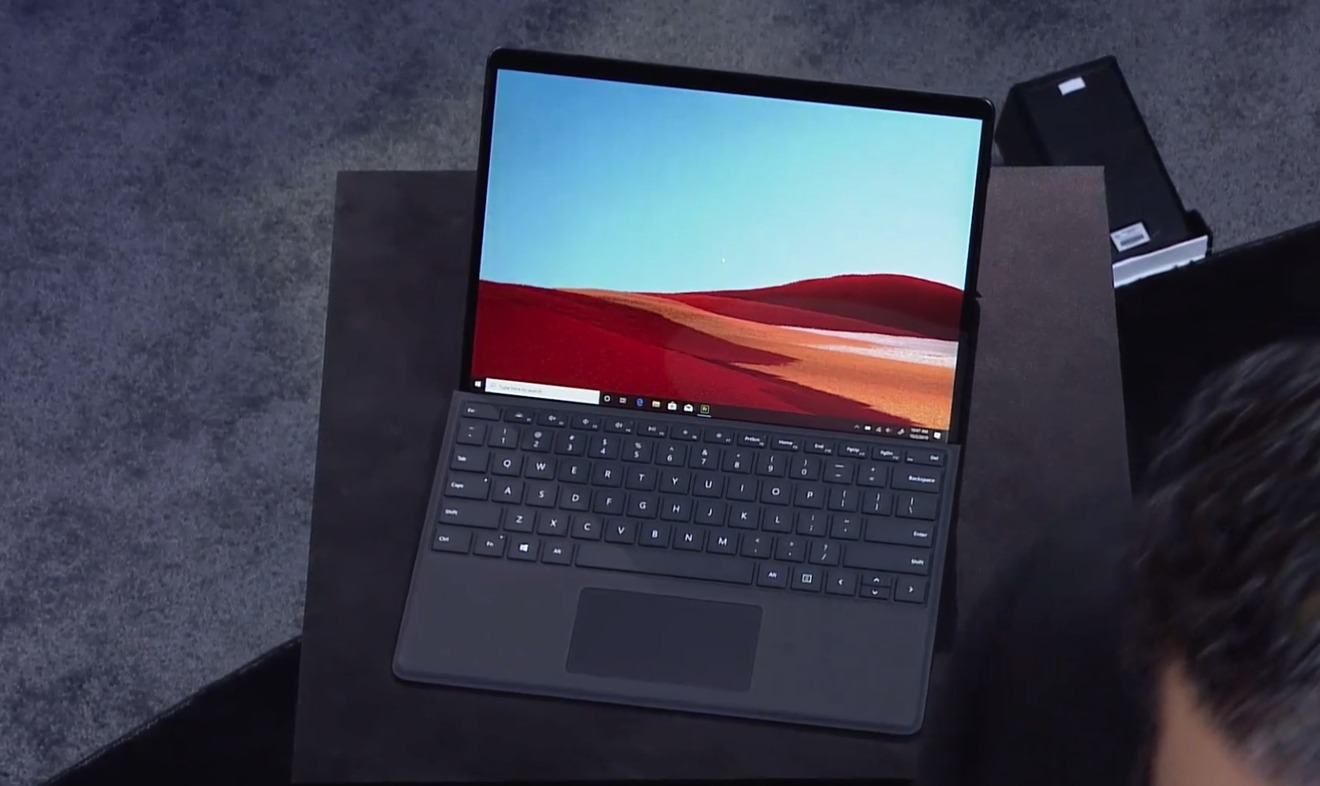At Microsoft's media event in New York on Wednesday, the Windows producer expanded its Surface hardware line with new models, including updates to the Surface Laptop line and the Surface Pro, and the debut of the ARM-powered Surface Pro X.
Surface Pro X
The new Surface Pro X is 13 inches diagonal in the same chassis size as the Surface Pro. The display has a 2880 x 1920 resolution, at 267 PPI with a 1400:1 contrast ratio. The unit measures 5.3 mm at thinnest point, and weighs 1.68 pounds.
Wired connections are provided by USB-C ports. Microsoft also says that it has "constant LTE connectivity." A new Surface Slim Pen embeds into the space between the Type Cover and the Surface Pro X itself.
Microsoft's SQ1 processor is based on the Qualcomm Snapdragon processor, with custom cores for artificial intelligence processing, according to Microsoft. The company also says that it uses a custom GPU, co-developed by Qualcomm and Microsoft.
The Surface Pro X also uses "full Windows 10" according to the company. It will ship in "early November" for $999 and up.
Surface Laptop 3
The Surface Laptop 3 is a more conventional notebook compared to the Surface, following on from last year's model, in that it is a fully-fledged notebook rather than a tablet hybrid. New for this year is the inclusion of 13-inch and 15-inch models, giving potential customers a choice of something similar in size to the Surface Laptop 2 or a larger version.
Microsoft spent a considerable amount of time talking about usability for the device, including a big focus on the input side of things. The keyboard has been updated to have 1.3mm of travel, with each key having a slight dish shape and claimed to provide an almost silent typing experience, while the trackpad is 20% larger than the Laptop 2.
Inside the Surface Laptop 3 13-inch is an Intel 10th-gen "Ice Lake" quad-core processor, claimed to be twice the power of the Surface Laptop 2, and allegedly three times more powerful than the MacBook Air. The exact specifications of neither the MacBook Air nor the Surface Book are mentioned, so it is unclear what specifically is being compared. Historically, Microsoft has done this comparison with the highest-end Surface product, versus the entry-level Mac.
Within the 15-inch model, Microsoft has left out Intel in favor of its main rival. The larger model uses an AMD processor, using the "Ryzen Surface Edition" chip which Microsoft co-engineered with the processor maker.
Fast charging has been introduced to the entire Surface line for the new launches, with an 80% charge possible after an hour of charging.
Preorders are open now from the online Microsoft Store and B&H Photo, priced at $999 and $1,199 for the 13-inch and 15-inch models respectively, with Microsoft shipping them on October 22.
Surface Pro 7
The Surface Pro 3 retains the same size as the previous model. The updated Surface Pro 7 comes configurable with a Core i3-1005G1, Core i5-1035G4, or Core i7-1065G7 processor. Storage is available in capacities from 128GB to 1TB. Microsoft is allowing for 4GB, 8GB, or 16GB of RAM.
The display is a 12.3-inch touchscreen, running at a 2736x1824 resolution at 267 PPI, at a 3:2 ratio. The company is still using the Surface Connector for power, but has replaced the miniDisplayPort with a USB-C port. It isn't presently clear if the Surface Pro can be charged with that port. Other ports include a single USB-A port, a microSDXC slot, and a 3.5mm headphone jack.
The rear camera is an 8MP unit, and the front-facing camera is 5MP.
The Surface Pro 7 will ship on October 22, and will start at $749 from Microsoft and B&H Photo.
 Malcolm Owen
Malcolm Owen








-m.jpg)






 Amber Neely
Amber Neely



 Christine McKee
Christine McKee


 William Gallagher
William Gallagher


-m.jpg)






50 Comments
As bad as these Surface products are I'm glad someone out there is offering some competition for Apple.
Has anybody been watching the keynote? Who in the world is that clown talking about the new Surface Laptop 3? You’d think he’s describing a cure for cancer.
Live stream:
https://www.youtube.com/watch?v=dmaioTs0NH8
That artist was fine but good god, those guys are terrible.
So my guess is this is a Snapdragon 8cx derivative with an added AI core.
Still can't keep up with the A12X from last year, and the A13X is right around the corner. I really would like to see an A13X powered MacBook. It's time for Apple to take their complete control of the entire stack (hardware/software/dev tools) and apply that to an ARM MacBook.